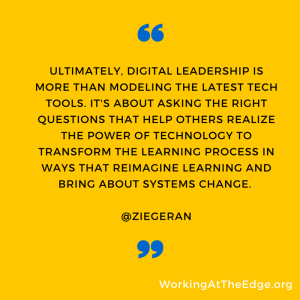 This is the first in a series of four posts that have emerged as a result of a week-long trip to Silicon Valley with a group of educational leaders from the University of Pennsylvania Midcareer Doctoral Program in Educational Leadership. Be sure to check out previous blog posts providing my reflections on the daily adventures. You can find the previous posts in this series at these links:
This is the first in a series of four posts that have emerged as a result of a week-long trip to Silicon Valley with a group of educational leaders from the University of Pennsylvania Midcareer Doctoral Program in Educational Leadership. Be sure to check out previous blog posts providing my reflections on the daily adventures. You can find the previous posts in this series at these links:
- 4 cultural signs you’re ready to push educational innovation
- Does your leadership need a system software upgrade?
What is digital leadership? Eric Sheninger proposes:
Digital leadership can thus be defined as establishing direction, influencing others, and initiating sustainable change through the access of information, and establishing relationships in order to anticipate changes pivotal to school success in the future. It requires a dynamic combination of mindset, behaviors, and skills that are employed to change and/or enhance school culture through the assistance of technology. (from Leading in the Digital Age)
What does this look like? It would seem that using technology tools for communication, public relations, branding and certain kinds of professional development (what Sheninger refers to as pillars of digital leadership) are good entry points. But it’s important we as digital leaders not stop there. In this post, I’d like to challenge our thinking with these two questions: How are we applying our digital leadership beyond these entry points? How are we engaging in richer conversations about learning and learning environments?
Having visited schools and ed-tech startups as part of #PennSV16, I saw the lack of deep conversation about technology and learning. This lack of mature digital leadership has resulted in pockets of change at the classroom level, but very little change at the systems level. And until we engage the full spectrum of digital leadership, we will never reach the level of systemic change.
Startups like ClassDojo and Nearpod, for example, have (intentionally or unintentionally) circumvented leadership and gone straight to tech-enthusiastic teachers for feedback on product development. As I see it, too much technology use in our classrooms is about making the traditional content-push model more efficient. And because so few (teachers and leaders) are asking the right questions about how technologies and tech tools advance a more progressive vision for education, we get products and services that may seem great, but really do nothing but reinforce an outdated vision of learning.
How might digital leadership disrupt the echo chamber and move our learning environments (and edtech companies) toward a more progressive vision of learning? Here is a 4 step process that I have found to help advance the conversation:
- Build a culture of inquiry. As leaders, we can’t force change. We can only build the culture in which others feel invested to change. The way to do this is to build a culture of inquiry where questions are the norm and the prevailing belief is there is always room for improvement. Without a culture of inquiry, there is no foundation on which to critically explore the affordances and constraints of a particular technology or tech tool.
- Clearly articulate your set of beliefs about learning in a digital ecology. The more conversations I have with educators, the more I see this as a significant gap in our work. Many educators, including leaders, lack a clear vision of what a digital learning ecology could and should look like. To get there, try these questions: (1) What do we believe is the purpose of education? (2) What knowledge, skills and dispositions do our graduates need to be wildly successful in a connected world of information abundance? (3) What should the learning environment look like to foster wildly successful learners?
- Understand how technology and technology tools advance the vision for learning. Having clearly articulated a vision for learning, ask how a particular technology advances (or hinders) that vision. Does it merely add an efficiency? Or does it allow learners to be wildly successful in ways not possible without the technology? Of course, this does require an understanding of the affordances and constraints of the particular technology.
- Influence and engage stakeholders. Ask questions! Bring others into the conversation and shape the collective understanding of which tools most advance the vision. Ultimately, digital leadership is more than modeling the latest tech tools. It’s about asking the right questions that help others realize the power of technology to transform the learning process in ways that reimagine learning and bring about systems change. What questions are we asking leaders, teachers and tech start-ups? What questions should we be asking?
Where are you on the digital leadership continuum? How will you advance your digital leadership?
Connect with Randy on Twitter and on the TLTalkRadio podcast!
Get new content delivered to your inbox and the ebook 3 Key Principles of Digital Transformation. The ebook contains valuable information from my experience leading a digital transformation and working with a variety of stakeholders over the past decade.
- A silver lining - January 22, 2022
- Is our use of tech working against us? 🤔 - September 8, 2021
- What’s NOT going to change in the next 10 years? 🤔 - September 7, 2021
[…] So you think you’re a digital leader? – March 31, 2016 […]